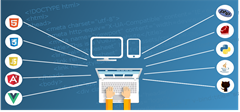It’s important to know the top 5 tips that you can use for optimizing your websites and give you that need for speed. A slow website can hinder a users’ experience on your site and potentially drive away future traffic. There is a lot of factors in web design that can bog down your site. With that said, here are five ways you can improve your site speed.
Optimize Your Images
It’s essential to make sure you’re using the right images, the correct size, the proper format. You want to be 100% confident that you’re doing everything you can to make sure your images are compressed. If you don’t need transparency, then don’t use a PNG, use a JPEG. If the image is going to be a background image, and you’re going to have things on top of it, then you might want to make your image more crispy or decrease the quality a little. You want to try and keep your images under 150 KB. Furthermore, the smaller you can make it, the better.
You never want to have a 5000×5000 5MB JPEG image trying to load up on your website. Also, make sure you’re running through software such as image optime, so it pulls all the metadata out of the image you don’t need.
Reduce the Amount of HTTP Requests that are on your Site
If you’re unfamiliar with what an HTTP request is, it’s your website calling out to a server and grabbing the information, and then bringing it back and delivering it. The HTTP requests gather every image, style, file sheet, JavaScript file, and much more. Everything you have on your website has to go out to the server, make that request, bring it back, and then display it. With that said, the more times you have to do that, the slower your website will be.
You must minimize the number of requests you make on each page and through your site as a whole. In this situation, less is more. Are you wondering how you can reduce the number of HTTP requests? You can reduce the amount of imagery on your site. Furthermore, try to use a CSS processer, so you don’t have multiple style sheets, and they all get combined into one JavaScript or one style sheet.
Use Text Instead of Images
Using text allows the browser to be faster. Therefore, if you have a blog list with numerous articles, think about if you need an image on all of them. It’s easier to continually load more imagery since an image speaks a thousand words. However, if you can find a few words that can speak a thousand words, then that would be better than an image that takes significantly more time to load.
Minify Your Scripts and CSS Files
If you have multiple scripts and CSS files, use a processor and turn all of your files into one. Even if you have multiple JavaScript files, turn them into one. However, once you turn all of your files into one, make sure you then minify them. Minifying is the process of taking all your CSS data and putting it into an illegible format that only computers can read. Don’t worry if you can’t read the format, as long as the computer can read it and you get the same result; you’re good to go. If you can, why not save yourself from reading thousands of lines of code when you can make the format smaller
Use a CDN (Content Delivery Network)
When it comes to a CDN, you can use something like Cloudflare. CDN’s are supercharged servers that load all your content faster than your shared hosting. For a better context, imagine your Amazon packages being delivered to you in a Ferrari rather than the standard van.
In Summary
It’s important that you’re always checking the performance of your website. There are numerous tools out there on the web that you can utilize. If you need help with your web design, TOLS Multimedia provides expert web design services.

